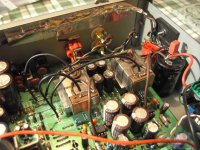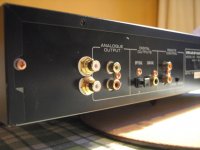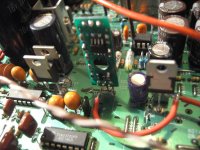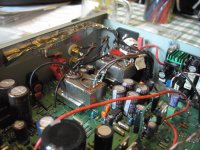regarding clock signal output, could be right to connect output of RD14, near dac, with U174 hole near R104?
But where i could connect coaxial cable shield, and 47 ohm resistors is in serie with signal?
But where i could connect coaxial cable shield, and 47 ohm resistors is in serie with signal?
Hi Ray
Mundorf had a typo on some their pdfs, originally their 25V 22000uF stated 0.22 ohm which was too low. The updated sheet then stated 22 ohm. Comparing that with a 25V 22000 BHC Aerovox with 48 ohm @ 100Hz.
I looked at two of their datasheets yesterday, and both give the ESR in mohm. So that seems correct then. But my HV lytics are also stated in mohm, and that can't be true, can it? I mean, 0.8mohm for a 100uF, it must be 0.8 ohms.
They are listed as "high volgate" caps on their site, so now I doubt everything they write...
Ray
regarding clock signal output, could be right to connect output of RD14, near dac, with U174 hole near R104?
But where i could connect coaxial cable shield, and 47 ohm resistors is in serie with signal?
Hi R!
You don't need 47 ohm resistors for termination because the length is too short for it to matter. Also, it doesn't matter if you use 50ohm or 75ohm coax. Get some with lowest capacity. Coax goes to RD14 indeed, and shield to nearby GND. Remove U145 and U174 near decoder. Then to R104...
Marantz made a big mistake here! In the schematic, the clock signal is connected to pin 21, CRIN which is correct. But if you look closely on the board layout, you'll see that they reversed pins 21 and 22! 😱 Marantz connected the clock to the OUTPUT instead of the INPUT. So you have to make sure you connect the coax to pin 21. Shield goes to nearest GND, R104 can stay in place.
Ray
big marantz mistake
Ciao Ray!
Incredible, clock signal is inverted...
So i imagine this could be a meaningful improvement...
Regarding HF signal from TDA1302T appears in 67 along a very short path, so i don't know if is appropriate to use a coaxial.
Instead, what about for other "B" signal? I refer to the pins 9/10/11 of dac, and R501, 502, 503 resistor near decoder..
maybe a good tweak to use coaxial for these link?
And another question about caps... 220uF Sanyo OS Con: what about 2,2 uF bypassing?
Ciao Ray!
Incredible, clock signal is inverted...
So i imagine this could be a meaningful improvement...
Regarding HF signal from TDA1302T appears in 67 along a very short path, so i don't know if is appropriate to use a coaxial.
Instead, what about for other "B" signal? I refer to the pins 9/10/11 of dac, and R501, 502, 503 resistor near decoder..
maybe a good tweak to use coaxial for these link?
And another question about caps... 220uF Sanyo OS Con: what about 2,2 uF bypassing?
Last edited:
Yep they did it before Obama:
Marantz & Philips people: "yes we can!"
side note, funny I've just noticed we French use "ciao" just to say goodbye... sacrés français!
Marantz & Philips people: "yes we can!"
side note, funny I've just noticed we French use "ciao" just to say goodbye... sacrés français!
Riccardo, I didn't realise you had a CD67. I'm not sure what differences there are in that area but in the CD63 it was from the junction of R108/Q103 to R501 I connected a coax run. It's a very long run...
I looked at two of their datasheets yesterday, and both give the ESR in mohm. So that seems correct then. But my HV lytics are also stated in mohm, and that can't be true, can it? I mean, 0.8mohm for a 100uF, it must be 0.8 ohms.
They are listed as "high volgate" caps on their site, so now I doubt everything they write...
Ray
LOL they should say 'higher voltage'. It's a good job they sound good.
Brent
Riccardo, I didn't realise you had a CD67. I'm not sure what differences there are in that area but in the CD63 it was from the junction of R108/Q103 to R501 I connected a coax run. It's a very long run...
I don't bother with the coax in the 67, it is only about 1" long.
Brent
thanks Simon and Brent.
What about coax mod on others "B" signal to Decoder?
and regarding Sanyo Os con Bypassing?
What about coax mod on others "B" signal to Decoder?
and regarding Sanyo Os con Bypassing?
Last edited:
I've been messing with transformer output a little more. I found some resistance (470R) in series with LON, LO, RON and RO helped to reduce the noise but also made the sound more limp with soft bass. 100R was a better compromise.
I have now also tried connecting the + input of the tx to pin 1 (1st op-amp output) of my LM4562 so I have half the filtering and just 1 of 3 active stages and then my line transformers.
This, as expected, provides decent noise levels, a decent bass output and a sound that isn't very harsh, retaining some of the transformer's music making abilities. This is a good compromise, I can see why Audiocom connect those fancy transformers after an op-amp, even though it sounds like a funny thing to do.
Simon
I have now also tried connecting the + input of the tx to pin 1 (1st op-amp output) of my LM4562 so I have half the filtering and just 1 of 3 active stages and then my line transformers.
This, as expected, provides decent noise levels, a decent bass output and a sound that isn't very harsh, retaining some of the transformer's music making abilities. This is a good compromise, I can see why Audiocom connect those fancy transformers after an op-amp, even though it sounds like a funny thing to do.
Simon
I don't know, but it does 🙂
It does some extra filtering and isolates ground from the connected amp. These effects may be positive, or not. There must be some reason.
It does some extra filtering and isolates ground from the connected amp. These effects may be positive, or not. There must be some reason.
Yes, it's a voltage output dac and wants to 'see' a very high impedance as a load for best accuracy.
Bolting a transformer on directly after it requires the dac chip drive the interconnect cable capcitance and the preamp input -something it is really not designed to do.
Bolting a transformer on directly after it requires the dac chip drive the interconnect cable capcitance and the preamp input -something it is really not designed to do.
Yeh, it doesn't seem happy with that proposition. It's a bit like a "passive preamp" in its effects on sonics - smooth but lacking immediacy, full texture, bass dynamics and bite. I like this player now but I think next time I mod one I'll strive for a discrete output stage as it'll be no more expensive really and probably even better.
Ricardo,
The transformer I used doesn't change impedance I don't think, it's a 1:1 ratio model so I believe it doesn't change the voltage or impedance much. The op-amp deals with the problems and filters the noise, whilst still allowing a fairly pure sound subjectively. I haven't used the player with just the single op-amp but I don't think it would sound as nice as with the transformer.
Simon
Ricardo,
The transformer I used doesn't change impedance I don't think, it's a 1:1 ratio model so I believe it doesn't change the voltage or impedance much. The op-amp deals with the problems and filters the noise, whilst still allowing a fairly pure sound subjectively. I haven't used the player with just the single op-amp but I don't think it would sound as nice as with the transformer.
Simon
single op amp before tx? simple filter before tx? , impedance matching theory? where did those ideas come from????
Erm, you? Not that I think it's matching impedance, hence sounding soft.
You certainly said try op-amp before tx and that was a good call, can't believe you didn't try it yourself. It is pretty good, good enough that I've put the lid on and all the screws in!
And, Ian, you also said try HDAM after tx. I don't fancy wiring that one up to be quite honest, but it is an intriguing idea! It would lose the benefit of isolating the player's ground from the pre-amp, if such a thing is a benefit.
Simon
You certainly said try op-amp before tx and that was a good call, can't believe you didn't try it yourself. It is pretty good, good enough that I've put the lid on and all the screws in!
And, Ian, you also said try HDAM after tx. I don't fancy wiring that one up to be quite honest, but it is an intriguing idea! It would lose the benefit of isolating the player's ground from the pre-amp, if such a thing is a benefit.
Simon
LOL! Sorry Simon, couldn't resist!!!🙄
Indeed, i'm glad that the single opamp stage is sounding much better. I'm really not sure about the hdam stage tbh.
Given what I've learned, simple is usually better when you can get away with it. I also think that if you like the TX characteristics, if could be worth trying with the DOS and i'd poss try the HDAM before the tx too (although I'm really not convinced about the HDAM design at all and it would need to be modified to accept the output from the dac itself)!
As for trying it out! I only got so far then gave up so i'm pleased you tried these idea's and its working for you. Given this, when i'm done playing with my Meridian, i'll have another go a the 63!
Seriously, it looks like you're heading in the right direction and thats good for us all! 😎
Indeed, i'm glad that the single opamp stage is sounding much better. I'm really not sure about the hdam stage tbh.
Given what I've learned, simple is usually better when you can get away with it. I also think that if you like the TX characteristics, if could be worth trying with the DOS and i'd poss try the HDAM before the tx too (although I'm really not convinced about the HDAM design at all and it would need to be modified to accept the output from the dac itself)!
As for trying it out! I only got so far then gave up so i'm pleased you tried these idea's and its working for you. Given this, when i'm done playing with my Meridian, i'll have another go a the 63!
Seriously, it looks like you're heading in the right direction and thats good for us all! 😎
I don't think I've advanced anything on this thread by trying it, merely explored one particular avenue a little more. It might satisfy some people's curiosity.
I do think a good simple discrete active stage would better it, but there is simplicity in running a tx after just one op-amp stage. The only real complication is having to drill new holes to mount isolated sockets... though I don't know that anything bad would happen if you didn't bother and just mixed the grounds together. If you connect both outputs to the preamp they'll almost certainly get mixed anyway (they do in my preamp).
Simon
I do think a good simple discrete active stage would better it, but there is simplicity in running a tx after just one op-amp stage. The only real complication is having to drill new holes to mount isolated sockets... though I don't know that anything bad would happen if you didn't bother and just mixed the grounds together. If you connect both outputs to the preamp they'll almost certainly get mixed anyway (they do in my preamp).
Simon
Some pics
Here are a few pics of this one I've just finished. Having 2 sets of output sockets makes it easy to compare one output to the other - instant A/B switching using the source selector.
Also there's a pic showing where I routed the DAC wires (later removed in favour of op-amp connection).
Simon
Here are a few pics of this one I've just finished. Having 2 sets of output sockets makes it easy to compare one output to the other - instant A/B switching using the source selector.
Also there's a pic showing where I routed the DAC wires (later removed in favour of op-amp connection).
Simon
Attachments
- Home
- Source & Line
- Digital Source
- Marantz CD63 & CD67 mods list




